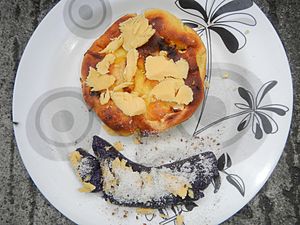Puto bumbong facts for kids
 |
|
| Alternative names | Puto bombong |
|---|---|
| Course | Dessert |
| Place of origin | Philippines |
| Serving temperature | Room temperature, hot |
| Main ingredients | Pirurutong glutinous rice, white glutinous rice, muscovado, grated coconut, butter/margarine, sesame seeds |
| Variations | puto |
| Similar dishes | kue putu, putu bambu, puttu |
Puto bumbong is a special Filipino purple rice cake. It is cooked by steaming it inside bamboo tubes. People usually enjoy this yummy treat during the Christmas season in the Philippines. It's a kind of steamed rice cake called "puto."
Contents
What's in a Name?
The name "Puto bumbong" comes from two Tagalog words. "Puto" means steamed rice cakes. "Bumbong" or "bombong" means "bamboo tube." So, it's a "steamed rice cake from a bamboo tube!" Sometimes, people spell it a bit differently, like "puto bungbong."
How It's Made
Puto bumbong is made from a special kind of glutinous rice. This rice is called pirurutong and is deep purple, almost black. It is often mixed with white glutinous rice, known as malagkit. Sometimes, regular white rice is used to make it less chewy.
First, the rice grains are soaked in water overnight. This soaking gives the rice a slightly tangy taste. Then, the soaked rice is drained. It is packed tightly into bamboo tubes. These tubes are traditionally greased with coconut oil. Today, people often use butter or margarine instead.
The rice is then steamed inside the bamboo tubes. This cooking method gives the puto bumbong its unique cylindrical shape. After steaming, the warm rice cake is served on banana leaves.
Delicious Toppings
Once served, puto bumbong is usually topped with more butter or margarine. Then, it's sprinkled with muscovado sugar. This is a type of brown sugar. Grated coconut is also a common topping.
Some people add sesame seeds for extra flavor. Other special toppings include condensed milk or even cheese. Sometimes, you might find it with leche flan on top!
A Christmas Tradition

In the Philippines, which is mostly Catholic, puto bumbong is a popular snack. It is often eaten for breakfast during the Christmas season. It is closely linked to the nine-day traditional Simbang Gabi novena. During this time, you'll find stalls selling puto bumbong outside churches.
Different Kinds
Modern puto bumbong might be made using metal cylinders. Sometimes, regular food steamers are used instead of bamboo. These versions might be shaped into small balls or long tubes.
Some modern recipes don't use the special pirurutong rice. Instead, they might use purple food coloring. Or they might use purple yam (ube) flour. However, many people feel these versions are not the real thing.
Restaurants sometimes create new dishes inspired by puto bumbong. These can include ice cream flavors or pancakes. You might even find puto bumbong cakes or empanadas.
A different version from Batangas and Pampanga is called putong sulot. This one uses white glutinous rice. Unlike puto bumbong, you can find putong sulot all year round.
Similar Dishes Around the World
Other countries in Maritime Southeast Asia have similar dishes. In Indonesia and Malaysia, they are called kue putu or putu bambu. These are usually green because they use pandan leaves for flavor.
In India and Sri Lanka, there's a dish called puttu or pittu. It is also steamed in bamboo tubes. However, puttu is a savory dish, not a dessert.
These related dishes use regular rice flour. But they all share the special way of cooking in bamboo tubes.
See also



